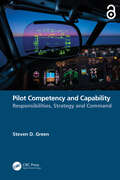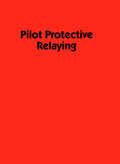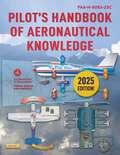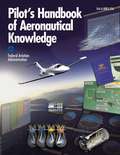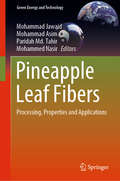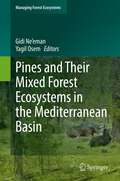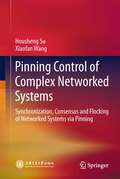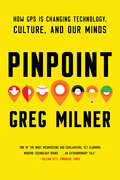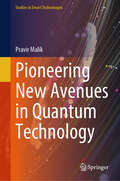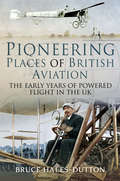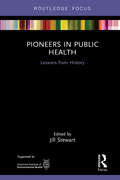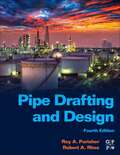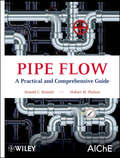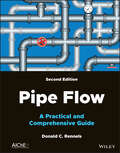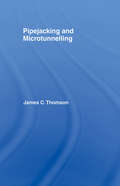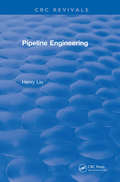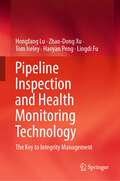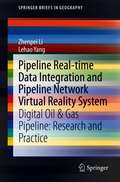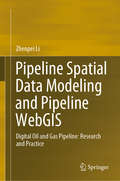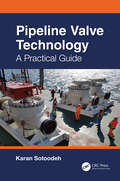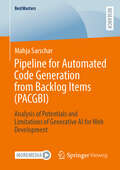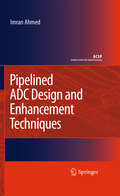- Table View
- List View
Pilot Competency and Capability: Responsibilities, Strategy, and Command
by Steven D. GreenPilot Competency and Capability presents strategies for the air carrier pilot-in-command operating complex engineered systems within a complex natural environment. It bridges the gap between academic books and practical application by providing real-world examples of how various safety and operational theories work in practice. The book advises on how to develop concepts, strategies, and ways of thinking that integrate with existing structures and FAA regulations, while understanding how engineered systems and codified structures interface with complex natural environments. It considers how the prescribed safety margins function to manage emergent behaviors of both the natural environment and the engineered systems. The book is intended for airline pilots, training captains, simulator instructors, and aviation students taking courses in aviation safety, risk management, and flight safety to improve in-flight decision-making, risk analysis, and strategic planning.
Pilot Protective Relaying (Electrical Engineering and Electronics #109)
by ElmoreThis text concentrates on the fundamentals of protective relaying and aims to provide lasting information in intelligible language. It covers the relative qualities of modern transmission line systems, communications channels, three-terminal applications and program design for microprocessors, and also supplies an encyclopaedic bibliography listing professional papers useful to the relay engineer.
Pilot's Handbook of Aeronautical Knowledge: FAA-H-8083-25C (ASA FAA Handbook Series)
by Federal Aviation AdministrationTHE ESSENTIAL FULL-COLOR HANDBOOK FOR PILOTS, IN A NEW 2023 EDITION! This official Federal Aviation Administration (FAA) handbook provides basic knowledge essential for pilots on topics like decision-making, aerodynamics, flight controls, weather theory, airport operations, and more. Pilot's Handbook of Aeronautical Knowledge introduces pilots to the broad spectrum of information that will be needed as they progress in their pilot training. Written for the pilot preparing for a remote, sport, private, commercial, or flight instructor certificate, it is a key reference with all the information necessary to operate an aircraft and to pass the FAA Knowledge Exam and Practical Test. Chapter subjects include the following: Introduction to Flying Aeronautical Decision-Making Aircraft Construction Principles of Flight Aerodynamics of Flight Flight Controls Aircraft Systems Flight Instruments Flight Manuals and Other Documents Weight and Balance Aircraft Performance Weather Theory Aviation Weather Services Airport Operations Airspace Navigation Aeromedical Factors Readers are introduced to flying and a history of flight, criteria and examinations required for earning various pilot certificates, how to plan their flight education, and more. With dozens of full-color illustrations, photographs, diagrams, graphs, and charts, this handbook provides crucial tools for aspiring pilots in their knowledge exams and beyond. Beginners and advanced pilots alike will find the Pilot's Handbook of Aeronautical Knowledge to be a critical resource for all things aviation, updated with the most current FAA information, an index, a glossary, and appendices of common acronyms, abbreviations, NOTAM contractions, and airport signs.
Pilot's Handbook of Aeronautical Knowledge: Faa-h-8083-25, December 2003 (FAA Handbooks Ser.)
by Federal Aviation AdministrationPilot's Handbook of Aeronautical Knowledge, created by the Federal Aviation Administration, is the official reference manual for pilots at all levels. An indispensable and invaluable encyclopedia, it deals with all aspects of aeronautical information.Each chapter focuses on a different area that pilots are tested on in flight school and must need to know before they fly a plane on of their own. These topics include:aircraft structureprinciples of aerodynamicsflight controlsaircraft systemsflight instrumentsand moreFlight manuals and documentation are also covered, as is specialized information on such matters as weight and balance, aircraft performance, weather, navigation, airport operations, aeromedical factors, and decision-making while flying. An updated appendix, detailed index, and full glossary make this book easy to navigate and useful in quick reference situations.
Pineapple Leaf Fibers: Processing, Properties and Applications (Green Energy and Technology)
by Mohammad Jawaid Mohammad Asim Paridah Md. Tahir Mohammed NasirThis book presents recent research on natural fibers extracted from pineapple leaves. Covering several extraction processes, properties of pineapple leaf fibers and comparisons with other natural fibers, and their applications, it provides up-to-date information on the subject of natural fibers from prominent researchers in academia and industry as well as government/private research laboratories across the world. The book is a comprehensive reference resource for university and college faculties, professionals, postdoctoral research fellows, undergraduate/graduate students, researchers and scientists working in the areas of non-forest product utilization, natural fibers, and biomass materials.
Pines and Their Mixed Forest Ecosystems in the Mediterranean Basin (Managing Forest Ecosystems #38)
by Gidi Ne’eman Yagil OsemAlmost 20 years after the first MEDPINE book "Ecology, biogeography and management of Pinus halepensis and P. brutia forest ecosystems in the Mediterranean basin "(Ne'eman and Trabaud, 2000) was published, this new book presents up-to-date and state of the art information, covering a wide range of topics concerning Mediterranean pine trees growing in native and planted forests, their ecosystems and management. This will be an essential source of scientific information for learning, exploring planning and managing mediterranean pine and mixed forests. We focus on: genetics, adaptation, distribution and evolution; ecophysiology and drought resistance; pine and mixed forest ecosystems; forest dynamics biodiversity and biotic interactions; fire ecology; ecosystem services and policy; afforestation and management; all under the effect of global climate change. While forests are studied mainly in temperate and tropical zones, in the light of current climate change, focusing on Mediterranean forests growing in semi-humid to semi-arid zones is more important than ever. This book will include mostly review chapters (and two outstanding case studies) contributed by leading scientists, foresters and managers, and will serve as a scientific textbook for students of biology, agriculture and forestry, researchers of ecology forestry and related fields, forest managers, policy and decision makers.
Pines: Wayward Pines: 1 (The Wayward Pines Trilogy #1)
by Blake CrouchThe first book of the smash-hit Wayward Pines trilogy, from the New York Times bestselling author of Dark Matter, Recursion, and UpgradeOne way in. No way out.Secret Service agent Ethan Burke arrives in Wayward Pines, Idaho, with a mission: locate two federal agents who went missing in the bucolic town one month earlier. But within minutes of his arrival, Ethan is involved in a violent accident. He comes to in a hospital, with no ID, no cell phone, and no briefcase.As the days pass, Ethan&’s investigation turns up more questions than answers: Why can&’t he get any phone calls through to his wife and son in the outside world? Why doesn&’t anyone believe he is who he says he is? And what is the purpose of the electrified fences surrounding the town? Are they meant to keep the residents in? Or something else out?Each step closer to the truth takes Ethan farther from the world he knew, from the man he was, until he must face a horrifying fact—he may never get out of Wayward Pines alive.The nail-bitingly suspenseful opening installment in Blake Crouch&’s blockbuster Wayward Pines trilogy, Pines is at once a brilliant mystery tale and the first step into a genre-bending saga of suspense, science fiction, and horror.
Pinning Control of Complex Networked Systems
by Housheng Su Xiaofan WangSynchronization, consensus and flocking are ubiquitous requirements in networked systems. Pinning Control of Complex Networked Systems investigates these requirements by using the pinning control strategy, which aims to control the whole dynamical network with huge numbers of nodes by imposing controllers for only a fraction of the nodes. As the direct control of every node in a dynamical network with huge numbers of nodes might be impossible or unnecessary, it's then very important to use the pinning control strategy for the synchronization of complex dynamical networks. The research on pinning control strategy in consensus and flocking of multi-agent systems can not only help us to better understand the mechanisms of natural collective phenomena, but also benefit applications in mobile sensor/robot networks. This book offers a valuable resource for researchers and engineers working in the fields of control theory and control engineering. Housheng Su is an Associate Professor at the Department of Control Science and Engineering, Huazhong University of Science and Technology, China; Xiaofan Wang is a Professor at the Department of Automation, Shanghai Jiao Tong University, China.
Pinpoint: How Gps Is Changing Technology, Culture, And Our Minds
by Greg MilnerPinpoint tells the story of GPS, a scientific marvel that enables almost all modern technology--but is changing us in profound ways. Over the last fifty years, humanity has developed an extraordinary shared utility: the Global Positioning System. Even as it guides us across town, GPS helps land planes, route mobile calls, anticipate earthquakes, predict weather, locate oil deposits, measure neutrinos, grow our food, and regulate global finance. It is as ubiquitous and essential as another Cold War technology, the Internet. In Pinpoint, Greg Milner takes us on a fascinating tour of a hidden system that touches almost every aspect of our modern life. While GPS has brought us breathtakingly accurate information about our planetary environment and physical space, it has also created new forms of human behavior. We have let it saturate the world's systems so completely and so quickly that we are just beginning to confront the possible consequences. A single GPS timing flaw, whether accidental or malicious, could bring down the electrical grid, hijack drones, or halt the world financial system. The use, and potential misuse, of GPS data by government and corporations raise disturbing questions about ethics and privacy. GPS may be altering the nature of human cognition--possibly even rearranging the gray matter in our heads. Pinpoint tells the sweeping story of GPS from its conceptual origins as a bomb guidance system to its presence in almost everything we do. Milner examines the different ways humans have understood physical space, delves into the neuroscience of cognitive maps, and questions GPS's double-edged effect on our culture. A fascinating and original story of the scientific urge toward precision, Pinpoint offers startling insight into how humans understand their place in the world.
Pioneering New Avenues in Quantum Technology (Studies in Smart Technologies)
by Pravir MalikIn this book, the author challenges conventional probabilistic interpretations of quantum mechanics by introducing a framework of &“qualified determinism&” that reexamines the underlying principles of quantum theory. Central to this vision is the Quaternary Interpretation of Quantum Dynamics (QIQD), which employs a quaternary fractal pattern to offer a fresh perspective on the quantum realm and its role in advanced computational processes. Spanning 24 chapters across six parts, the text bridges foundational theory with forward-looking applications, envisioning transformative breakthroughs in quantum-based energy detection systems, room-temperature superconductors, QIQD-inspired nano-devices, and beyond. By uniting rigorous conceptual exploration with a bold technological outlook, this book significantly broadens the horizons of quantum science and paves the way for a new era of quantum innovation.
Pioneering Places of British Aviation: The Early Years of Powered Flight in the UK
by Bruce Hales-DuttonA high-flying tour of British aviation history—and the sites where trials and triumphs took place.From the beginning of the nineteenth century, Britain was at the forefront of powered flight. Across the country, many places became centers of innovation and experimentation, as increasing numbers of daring men took to the skies.In 1799, at Brompton Hall, Sir George Cayley Bart put forward ideas that formed the basis of powered flight. There were balloon flights at Hendon from 1862, though attempts at powered flights from the area, later used as the famous airfield, don’t seem to have been particularly successful. Despite this, Louis Bleriot established a flying school there in 1910.It was gliders that Percy Pilcher flew from the grounds of Stamford Hall, Leicestershire, during the 1890s. He was killed in a crash there in 1899, but Pilcher had plans for a powered aircraft which experts believe may well have enabled him to beat the Wright Brothers in becoming the first to make a fixed-wing powered flight. At Brooklands, unsuccessful attempts were made to build and fly a powered aircraft in 1906—but on June 8, 1908, A.V. Roe made what is considered the first powered flight in Britain from there—in reality a short hop—in a machine of his own design and construction, enabling Brooklands to call itself the birthplace of British aviation.These are just a few of the places investigated in this intriguing look at the early days of British aviation, which includes the first ever aircraft factory in Britain in the railway arches at Battersea; Larkhill on Salisbury Plain, which became the British Army’s first airfield; and Barking Creek, where Frederick Handley Page established his first factory.
Pioneers in Public Health: Lessons from History (Routledge Focus on Environmental Health)
by Jill StewartThe public health movement involved numerous individuals who made the case for change and put new practices into place. However despite a growing interest in how we understand history to inform current evidence-based practice, there is no book focusing on our progressive pioneers in public health and environmental health. This book seeks to fill that gap. It examines carefully selected public and environmental health pioneers who made a real difference to the UK’s health, some with international influence. Many of these pioneers were criticised in their life-times, yet they had the strength of character to know what they were doing was fundamentally right and persevered, often against many odds. Including chapters on: Thomas Fresh John Snow Duncan of Liverpool Margaret McMillan George Cadbury Christopher Addison Margery Spring Rice and others. This book will help readers place pioneers in a wider context and to make more sense of their academic and practitioner work today; how evidence (and what was historically understood by it) underpins modern day practice; and how these visionary pioneers developed their ideas into practice, some not fully appreciated until after their own deaths. Pioneers in Public Health sets the tone for a renewed focus on research into evidence-based public and environmental health, which has become subject of growing international interest in recent years.
Pipe Drafting and Design
by Roy A. Parisher Robert A. RheaPipe Drafting and Design, Fourth Edition is a tried and trusted guide to the terminology, drafting methods, and applications of pipes, fittings, flanges, valves, and more. Those new to this subject will find no better introduction on the topic, with easy step-by-step instructions, exercises, review questions, hundreds of clear illustrations, explanations of drawing techniques, methodology and symbology for piping and instrumentation diagrams, piping arrangement drawings and elevations, and piping isometric drawings. This fully updated and expanded new edition also explains procedures for building 3D models and gives examples of field-scale projects showing flow diagrams and piping arrangement drawings in the real world. The latest relevant standards and codes are also addressed, making this a valuable and complete reference for experienced engineers, too. Provides tactics on the drafting and design of pipes, from fundamentals to detailed advice on the development of piping drawings, using manual and CAD techniques Covers 3-D model images that provide an uncommon opportunity to visualize an entire piping facility Includes exercises and questions designed for review and practice Introduces the latest 3D modeling software programs and 3D scanning systems
Pipe Dreams: The Urgent Global Quest to Transform the Toilet
by Chelsea WaldFrom an award-winning science journalist, a lively, informative, and humorous deep dive into the future of the toilet—from creative uses for harvested &“biosolids,&” to the bold engineers dedicated to bringing safe sanitation to the billions of people worldwide living without—for fans of popular science bestsellers by Mary Roach. Most of us do not give much thought to the centerpiece of our bathrooms, but the toilet is an unexpected paradox. On the one hand, it is a modern miracle: a ubiquitous fixture in a vast sanitation system that has helped add decades to human lifespan by reducing disease. On the other hand, the toilet is also a tragic failure: less than half of the world&’s population can access a toilet that safely manages bodily waste, including many right here in the United States. And it is inefficient, squandering clean water as well as the nutrients and energy contained in the waste we flush away. While we see radical technological change in almost every other aspect of our lives, we remain stuck in a sanitation status quo—in part because the topic of toilets is taboo. Fortunately, there&’s hope—and Pipe Dreams daringly profiles the growing army of scientists, engineers, philanthropists, entrepreneurs, and activists worldwide who are overcoming their aversions and focusing their formidable skills on making toilets accessible and healthier for all. This potential revolution in sanitation has many benefits, including reducing inequalities, mitigating climate change and water scarcity, improving agriculture, and optimizing health. Author Chelsea Wald takes us on a wild world tour from a compost toilet project in Haiti, to a plant in the Netherlands that harvests used toilet paper from sewage, and shows us a bot that hangs out in manholes to estimate opioid use in a city, among many other fascinating developments. Much more than a glorified trash can, the toilet, Wald maintains, holds the power to help solve many of the world&’s problems, if only we can harness it.
Pipe Flow
by Donald C. Rennels Hobart M. HudsonPipe Flow provides the information required to design and analyze the piping systems needed to support a broad range of industrial operations, distribution systems, and power plants. Throughout the book, the authors demonstrate how to accurately predict and manage pressure loss while working with a variety of piping systems and piping components.The book draws together and reviews the growing body of experimental and theoretical research, including important loss coefficient data for a wide selection of piping components. Experimental test data and published formulas are examined, integrated and organized into broadly applicable equations. The results are also presented in straightforward tables and diagrams.Sample problems and their solution are provided throughout the book, demonstrating how core concepts are applied in practice. In addition, references and further reading sections enable the readers to explore all the topics in greater depth.With its clear explanations, Pipe Flow is recommended as a textbook for engineering students and as a reference for professional engineers who need to design, operate, and troubleshoot piping systems. The book employs the English gravitational system as well as the International System (or SI).
Pipe Flow: A Practical and Comprehensive Guide
by Donald C. RennelsPipe Flow Provides detailed coverage of hydraulic analysis of piping systems, revised and updated throughout Pipe Flow: A Practical and Comprehensive Guide provides the information required to design and analyze piping systems for distribution systems, power plants, and other industrial operations. Divided into three parts, this authoritative resource describes the methodology for solving pipe flow problems, presents loss coefficient data for a wide range of piping components, and examines pressure drop, cavitation, flow-induced vibration, and other flow phenomena that affect the performance of piping systems. Throughout the book, sample problems and worked solutions illustrate the application of core concepts and techniques. The second edition features revised and expanded information throughout, including an entirely new chapter that presents a mixing section flow model for accurately predicting jet pump performance. This edition includes additional examples, supplemental problems, and a new appendix of the speed of sound in water. With clear explanations, expert guidance, and precise hydraulic computations, this classic reference text remains required reading for anyone working to increase the quality and efficiency of modern piping systems. Discusses the fundamental physical properties of fluids and the nature of fluid flow Demonstrates the accurate prediction and management of pressure loss for a variety of piping components and piping systems Reviews theoretical research on fluid flow in piping and its components Presents important loss coefficient data with straightforward tables, diagrams, and equations Includes full references, further reading sections, and numerous example problems with solution Pipe Flow: A Practical and Comprehensive Guide, Second Edition is an excellent textbook for engineering students, and an invaluable reference for professional engineers engaged in the design, operation, and troubleshooting of piping systems.
Pipejacking & Microtunnelling
by James ThomsonCovers development of trenchless technology; pipejacking and microtunnelling methods equipment: shields and tunnel boring machines; pipejacking: line, drive pit, top side; equipment: microtunnelling; design concepts.
Pipeline Engineering (CRC Press Revivals)
by Henry LiuPipeline engineering has struggled to develop as a single field of study due to the wide range of industries and government organizations using different types of pipelines for all types of solids, liquids, and gases. This fragmentation has impeded professional development, job mobility, technology transfer, the diffusion of knowledge, and the movement of manpower. No single, authoritative course or book has existed to unite practitioners.In response, Pipeline Engineering covers the essential aspects and types of pipeline engineering in a single volume. This work is divided into two parts. Part I, Pipe Flows, delivers an integrated treatment of all variants of pipe flow including incompressible and compressible, Newtonian and non-Newtonian, slurry and multiphase flows, capsule flows, and pneumatic transport of solids. Part II, Engineering Considerations, summarizes the equipment and methods required for successful planning, design, construction, operation, and maintenance of pipelines. By addressing the fundamentals of pipeline engineering-concepts, theories, equations, and facts-this groundbreaking text identifies the cornerstones of the discipline, providing engineers with a springboard to success in the field. It is a must-read for all pipeline engineers.
Pipeline Inspection and Health Monitoring Technology: The Key to Integrity Management
by Zhao-Dong Xu Hongfang Lu Tom Iseley Haoyan Peng Lingdi FuThis book includes six chapters aiming to introduce global pipeline inspection and health monitoring technologies comprehensively. The pipeline is the blood vessel of the energy system and a vital lifeline project. After many years of service, the pipeline gradually enters the aging stage. Pipeline inspection and health monitoring can effectively reduce the failure and accident risks of the pipeline, and it is conducive to integrity management. Through case analysis, practitioners can have a deeper understanding of the application of related technologies.
Pipeline Pedagogy: Teaching About Energy and Environmental Justice Contestations (AESS Interdisciplinary Environmental Studies and Sciences Series)
by Valerie Banschbach Jessica L. RichThe proliferation of pipelines to transport oil and natural gas represents a major area of contestation in the landscape of energy development. Battles over energy pipelines pit private landowners, local community representatives, and environmentalists against energy corporations and industry supporters, sometimes drawing opposition and attention from well beyond the impacted regions, as in the case of the Standing Rock/Dakota Access Pipeline. Stakeholders must navigate complex government regulatory processes, interpret technical and scientific reports, and endure lengthy and expensive court battles. As with other forms of environmental injustice, the contentious construction of pipelines often disproportionately impacts communities of lower economic development, people of color, and indigenous peoples; pipelines also pose potential short and long-term health and safety threats. With the expansion of energy pipelines carrying fracked oil and gas across the United States and abroad, the moment is ripe for teaching about pipeline projects and engaging students and community members in learning about methods for mobilization. Our volume examines pedagogical opportunities, challenges, and interventions that campus-community engagement, and other kinds of community engagement, produce in relation to infrastructuring in the form of pipeline development.
Pipeline Real-time Data Integration and Pipeline Network Virtual Reality System: Digital Oil & Gas Pipeline: Research and Practice (SpringerBriefs in Geography)
by Zhenpei Li Lehao YangAs the second volume of the "Digital Oil & Gas Pipeline: Research and Practice" series of monographs, this book introduces the implementation strategies, examples and technical roadmaps of two important aspects of the Digital Oil & Gas Pipeline construction: pipeline real-time data integration and pipeline network virtual reality system. Two example of pipeline real-time data integration are elaborated: integration of pipeline WebGIS (Geographic Information System) and pipeline SCADA (Supervisory Control and Data Acquisition) via OPC (OLE for Process Control) technology, integration of pipeline network virtual reality system and pipeline SCADA via OPC, JNI (Java Native Interface) and SAI (Scene Access Interface). The pipeline network virtual reality system aims for the pipeline virtual expression, interaction, and 3D visual management. It can be used for pipeline route visual design and plan, immersive pipeline industry training, remote visual supervision and control, etc. The implementation details of the pipeline network virtual reality system, including 3D pipeline and terrain modeling with X3D (Extensible 3D) technology, improving large-scene display performance and speed in the network environment using LOD (Level of Detail) technology, interaction of virtual pipeline scenes, and pipeline 3D visual monitoring, are also introduced. The knowledge and experience delivered by this book will provide useful reference for the readers from the industries of oil & gas pipeline, GIS, Virtual Reality, industrial control, etc.
Pipeline Spatial Data Modeling and Pipeline WebGIS: Digital Oil and Gas Pipeline: Research and Practice (Springerbriefs In Geography Ser.)
by Zhenpei LiThis monograph, which is the first book focusing on "Digital Oil & Gas Pipeline", introduces the author’s long-term research and practice on this topic. It introduces the latest research on the core technologies of the Digital Oil & Gas Pipeline, such as WebGIS, GIS Web Services, pipeline supervisory control and data acquisition (SCADA), OLE for Process Control, networked virtual reality, and Extensible 3D. The keys to the Digital Oil & Gas Pipeline, including pipeline spatial data model, pipeline WebGIS, integrity of pipeline SCADA and pipeline GIS, pipeline networked virtual reality system, are also elaborated. The knowledge and experience delivered by this monograph will provide a useful reference for readers from the industries in Oil & Gas Storage and Transportation, pipeline automation, GIS, Virtual Reality, and related fields.
Pipeline Valve Technology: A Practical Guide
by Karan SotoodehThis book covers the life cycle of pipeline valves, the largest and most essential valves in offshore pipeline engineering. Discussing the design process, testing, production, transportation, installation, and maintenance, the book also covers the risk analysis required to assess the reliability of these valves. Pipeline valves require particular attention to ensure they are safely designed, installed, and maintained, due to the high stakes. Failure would result in environmental pollution, the destruction of expensive assets, and potential loss of life. Proper installation and upkeep require specialist processes throughout the life cycle of the valve. This book is a key guide to these processes. Beginning by looking at the design of pipeline valves, this book details how conserving weight and space is prioritized, how materials are chosen, how thickness is calculated, and how leakage is minimized. It then discusses production and specific welding techniques to bond dissimilar materials, alongside casting and machining. Building on other discussions in the text with case studies and questions and answers for self-study, this book is the ideal guide to pipeline valves. This book will be of interest to professionals in the industries of offshore oil and gas, material engineering, coatings, mechanical engineering, and piping. It will also be relevant to students studying coating and welding, or mechanical, piping, or petroleum engineering.
Pipeline for Automated Code Generation from Backlog Items: Analysis of Potentials and Limitations of Generative AI for Web Development (BestMasters)
by Mahja SarscharThis book investigates the potential and limitations of using Generative AI (GenAI) in terms of quality and capability in agile web development projects using React. For this purpose, the Pipeline for Automated Code Generation from Backlog Items (PACGBI) was implemented and used in a case study to analyse the AI-generated code with a mix-method approach. The findings demonstrated the ability of GenAI to rapidly generate syntactically correct and functional code with Zero-Shot prompting. The PACGBI showcases the potential for GenAI to automate the development process, especially for tasks with low complexity. However, this research also identified challenges with code formatting, maintainability, and user interface implementation, attributed to the lack of detailed functional descriptions of the task and the appearance of hallucinations. Despite these limitations, the book underscores the significant potential of GenAI to accelerate the software development process and highlights the need for a hybrid approach that combines GenAI's strengths with human expertise for complex tasks. Further, the findings provide valuable insights for practitioners considering GenAI integration into their development processes and set a foundation for future research in this field.
Pipelined ADC Design and Enhancement Techniques
by Imran AhmedPipelined ADCs have seen phenomenal improvements in performance over the last few years. As such, when designing a pipelined ADC a clear understanding of the design tradeoffs, and state of the art techniques is required to implement today's high performance low power ADCs.
